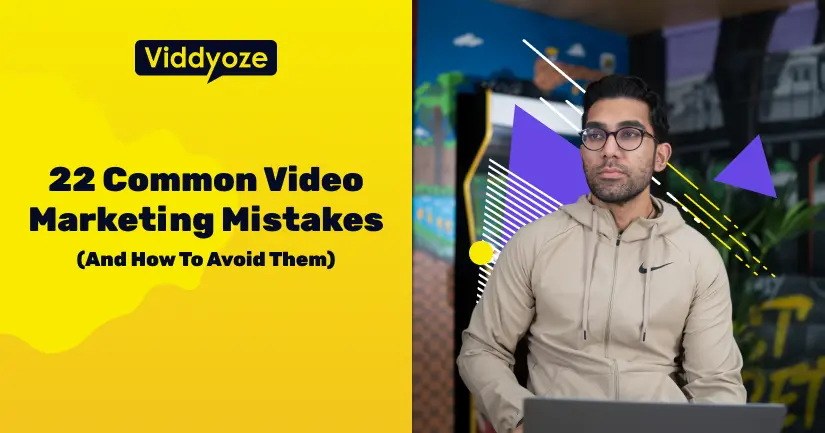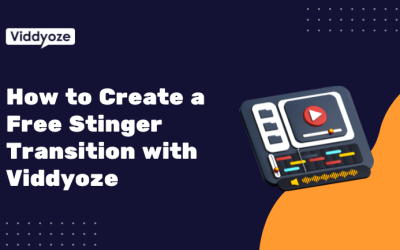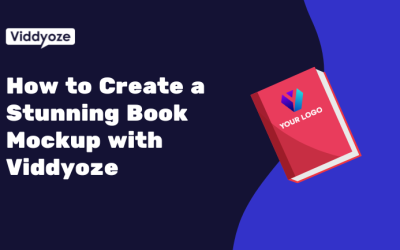Over the last decade, video content has become one of the most powerful tools in marketing. Don’t believe us? We’ll let the stats speak for themselves:
- Statista reports that online videos have a worldwide audience reach of 92%
- 87% of marketers told Wyzowl that video gave them a positive ROI
But for people new to the medium, video marketing mistakes are easy to make. What’s more, creating and executing a successful video marketing strategy can be tricky, which is why we’ve put together this guide.
Here, we’re going to show you the 22 most common video marketing mistakes and how you can avoid making them.
At Viddyoze, it’s our mission to give all businesses, no matter their size or budget, the ability to use video correctly. Using our super simple software, you can create scroll-stopping animated videos in a matter of minutes. Allowing you to execute an ambitious video marketing strategies at scale.
Read on and avoid the 22 biggest video marketing mistakes:
1. Posting YouTube Links To Your Social Media Accounts
The main aim of every social media platform is to keep you using its app or website for as long as possible.
So, if you post a link to another third-party platform, for example, a YouTube video link on Facebook, Facebook doesn’t like that. This is one of the most common video mistakes out there.
Social media platforms actually cap these posts from getting too many impressions. Both Facebook and Twitter have spoken about the importance for brands to post native video on their platforms in recent years.
To game the algorithm and boost your impressions, post your video file as an MP4 directly into your chosen platform (just be sure it’s been formatted to fit in terms of length and file size).
Viddyoze Pro Tip: If your goal is to drive more views to your YouTube videos, post a link in a comment below your MP4 file.
2. Not Embedding Videos Onto Your Landing Pages
Eye View Digital recently discovered that its website conversion rate shot up by 80%. How? The brand added video content to its landing pages.
The major takeaway here is that video marketing isn’t just for social media. It works across a whole range of platforms, including your website.
There are a few reasons for this.
Firstly, search engines love video. One study by Forrester found that pages with video were 53 times more likely to appear on the first page of results on Google.
Lastly, video keeps people on a landing page for longer. Wistia discovered that by hosting quality videos on their pages, average dwell time improved by 2 whole minutes.
Simply put, video content on your landing page means more sales.
3. Not Repurposing Your Old Videos
Most marketing campaigns require multiple videos so that viewers remain engaged and don’t lose interest. The only problem is that creating tons of new video can be time-consuming and hinder your other marketing efforts.
That’s why we recommend repurposing your old video in creative ways. Just because you’ve used a video once, doesn’t mean it won’t work again for future projects.
Here are a few simple ways to repurpose old content:
- Cut up a longer video into multiple, shorter videos with key selling points
- Transcribe a video into a blog post for an added SEO boost
- Use footage from a webinar and create an online training course
4. Relying On Third-parties To Create Your Video Content
One of the most common video marketing mistakes brands make is not creating their own content. Usually, there are two major reasons for this. Either you don’t have the skills to do it yourself, or you lack the time to learn. More often than not, it’s both.
But it doesn’t have to be that way. With Viddyoze, you can create highly engaging animated videos in a matter of minutes – even if you’ve never created a video before in your life! Our specialist software is so simple, that absolutely anyone can use it.
To produce studio-level videos for your brand all you need to do is:
- Sign up to the Viddyoze app
- Choose a template from our library
- Customize it with your branding and messaging
- Download and post
It means no more expensive video agency fees, no more long wait times for content, and total control over your video strategy.
Regular content is the secret to a successful video marketing strategy. With Viddyoze, you’ll be able to create new videos in-house, every day.
Get free access to our marketing video maker right now.
We’re offering all new customers a free 7-day trial. If you don’t like our product for any reason, you can cancel within this time and we won’t charge you a penny. Tap here to get started.
5. Not Using Exclusive Videos As A Lead Magnet
Too many people give their best marketing videos away for free. Sure, that might boost your views on YouTube, but when it comes to conversions, it’s a big video marketing mistake.
For top-tier content, it’s okay to make your target audience work a little harder.
We call that a “lead magnet” – a lead magnet is a marketing tool that allows you to convert a casual website visitor into a hard lead.
So how does it work?
Simply hide your video behind a contact form. To view the video, your potential customer must give you a name and email address. Once you have that vital data, it’s much easier to convert that person later on in the marketing funnel.
6. Using Thumbnails Which Don’t Stand Out
For many, video thumbnails are an afterthought – as long as the video is engaging, people will watch it, right?
Well, not exactly.
If your thumbnail doesn’t stand out, chances are, your target audience will skip right by it on a busy search results page.
What’s more, many people make the mistake of simply copying what their competitors are doing instead of creating an engaging thumbnail image that stands out.
Try a custom image with bold, on-brand colors that really pop (the brighter the better), and include a person or an image that captures the key theme of your video. Finally, add a mini-title of 4 to 6 words, max.
7. Forgetting To Record Your Webinars Or Live Videos
Hosting a webinar or live event? Whatever you do, don’t forget to hit record.
While that might sound obvious, often, marketers are so caught up in delivering the event, they completely overlook the fact that a successful webinar can be repurposed into other video marketing campaigns later down the line.
Whether you host the entire video on YouTube or cut it up into multiple “best bits” clips to promote your next event, there are tons of things you can do with this type of video marketing content.
Remember what we said about lead magnets earlier? Use your webinar in this way for all those who missed out on the live event.
8. Not Using Video In Your Email Campaigns
Video marketing mistakes don’t come much bigger than this one.
Because it’s very difficult to host an actual video in an email, many marketers don’t even consider this as a part of their content marketing strategy.
But there are ways to harness the power of video in your email campaigns – and the first is so simple, that you’ll kick yourself for not thinking of it sooner.
By just including the word “video” in your email subject lines, you can improve open rates by 6%, according to Campaign Monitor. That’s a big jump in opens, giving you a much better chance of converting those clicks into sales.
Within the email itself, try using a still image from your video with a “play button” call to action in the center that links to a landing page hosting your video.
9. Posting The Same Video Onto Every Social Media Platform
Social media platforms differ greatly. LinkedIn, for example, attracts a professional target audience, while TikTok is targeted at Gen Z. The content that performs for one, probably won’t work for the other.
As a result, creating videos with a “one size fits all” approach is one of the most common video marketing mistakes a content marketer can make. Ideally, each social media platform should have its own video marketing plan, and you should edit your content accordingly.
For example, YouTube favors long videos, such as explainer videos or brand documentaries, while Instagram and TikTok need shorter, more entertainment-focused clips.
Make your marketing efforts count, and research each platform thoroughly to see which types of content work best.
10. Not Having A Dedicated Presenter For Your Video Content
A presenter-led video adds a human element to your content, helping to make your brand more approachable, engaging, and memorable.
By using the same presenter across multiple videos, you can build a genuine relationship with your target audience. Plus, this also helps to establish your brand’s thought leadership credentials.
At Viddyoze, we use one of our founders Joey Xoto, but there are tons of other famous examples, such as Neil Patel, and Rand Fishkin from Moz.
Of course, these presenters can change over time. Employees may leave. You may grow to the point where you can use a local celebrity in some of your content. You can even use multiple presenters for different types of videos and marketing campaigns.
Viddyoze Pro Tip: For the best video performance, always write a video script before you host any visual content.
11. Not Updating Your Videos With New Facts And Statistics
720,000 hours of new content are uploaded to YouTube every day. Think about that for a second – it would take 82 years to watch one day’s worth of content!
The point is, with so much video creation happening on a daily basis, content goes out of date fast. The fresher the content, the better chance it will rank on search platforms, such as Google and YouTube Search.
For small changes, such as new text overlays for facts and stats, you can use Viddyoze – so long as you’ve kept the original footage, that is.
Viddyoze Pro Tip: If your video is totally out-of-date, for example, an explainer video for a product that doesn’t exist anymore, simply create a new up-to-date video and link from the description section of the old one. That way, you get two optimized videos appearing in the search engine results page (SERPS).
12. Not Including a Pre-Intro In Your Videos
The hardest part of video marketing is keeping people interested at the beginning of your content. In fact, research shows that marketers have just 5 seconds to hook their viewers in.
This is why you need a pre-intro in your videos. These short intros tell the viewer exactly what they can expect from your video, and they work particularly well for brand, product, or service-focused content.
Think of it as a sales pitch, where you list your video’s major selling points. Don’t hold back: tell the viewer exactly why they should watch your video and what they’ll get out of it.
Remember, keeping people engaged isn’t just important for conversions, it’s also vital for your video’s performance on YouTube. The more people that click off your video early, the less likely it is to appear in YouTube’s search results.
13. Making Your Video Too Long
The average attention span is shorter than ever, so avoid making videos that are far too long. To get the length of your video right, it helps to think on a platform-by-platform basis.
For example, the optimal length for a video on Facebook is less than a minute (if you’re aiming for a viral video, that is), 15 seconds on TikTok, around a minute for Instagram, and 10 minutes on YouTube (if you’re looking at money creating videos that host ads).
Of course, video length also depends on the type of video you’re making – for a promo video on Instagram stories, 10 seconds will do the trick, while an in-depth tutorial about front-end development for LinkedIn might need a little longer.
If you create videos that are too long, your viewers will bounce (stop watching) which will ruin your retention rate. For platforms such as YouTube, this is bad news, as it means your content won’t perform as well in YouTube searches.
14. Not Calling Your Viewers To Action
A video call to action is one of the best ways to convert viewers into leads – yet so many marketers forget to include them.
A call to action is a proven way to get a single message across, whether the aim is to increase sign-ups to your newsletter, boost sales, or get more YouTube subscribers.
There’s no reason to feel pushy. In the world of video marketing, it’s okay to tell people what you want them to do next. In fact, most viewers expect it.
15. Not Using Keyword Research To Give Your Videos An SEO Boost
As we’ve already mentioned in point number 2, videos are a tremendous way to boost your SEO, both for your website and on platforms like YouTube.
With a little research, you’ll give your content a much better chance of being found in the search results. After all, these are the terms your audience is actively looking for. They want to see this content.
There are tons of SEO practices out there but the most simple way to start is to look for a set of keywords related to your niche. It’s easiest to simplify this down to a single question: what is your audience looking for?
For example, for this article, think “video marketing tips” or “video marketing mistakes”. Once you have your main keyword, run this through a keyword research tool, such as Google Trends, Ahrefs’ Keyword Explorer, or YouTube Suggests, to flesh out your terms.
Ideally, you want a set of between 5 to 10 that you can include in your videos’ titles, descriptions, subtitles, and host landing pages.
16. Not Including Enough Brand Touchpoints
Effective branded content needs to be memorable. For every new person that watches your content, the minimum takeaway has to be your brand name. If they can’t remember that, how will they know who to come to when they’re ready to buy?
The simplest way to achieve this is with branded video animations, such as intros, outros, scene transitions, and lower thirds. These little touches add a constant reminder of your branding, without disrupting the flow and engagement of the video.
Defining your brand is a key component of brand marketing, and it’s why the most iconic brands in the world are instantly recognizable from their logos alone.
17. Creating Content Which Doesn’t Align With Your Marketing Goals
The biggest mistake most marketers make is aimless video production. By that, we mean they create one video after another with no clear goal or mission.
It’s content for content’s sake, and trust us, it never works.
Every piece of content you make needs a clearly defined marketing goal. That could be anything from sales and email sign-ups, to brand awareness and recruitment applications.
Whatever the goal is, there’s a specific video to achieve that. For example:
- Product videos are a great way to generate sales.
- Social media ads are perfect if you want to increase your brand awareness
- Tutorials and educational content can drive sign-ups and subscriptions
18. Posting Videos Which Don’t Tell A Story
Want your brand to stand out? Then tell a story.
Not only will it make consumers see your brand in a more positive way, but it could also allow you to up your prices, according to Journal of Brand Management.
The reason is simple. Stories are emotive and engaging. If you tell one well, people are more likely to remember who you are and what you stand for.
Think of Nike’s iconic Dream Crazy ad with Colin Kaepernick, or Hallmark’s Mom’s Love Is For Always. Both story-led ads at their finest. You can also go the mini-doc route. Clothing brand Patagonia is a master at this type of story-led, journalistic-style content.
19. Not Investing In Quality Video Production
Nothing turns a viewer off faster than a cheap-looking, low-quality video. Because nobody wants to watch a grainy screen with poor sound and color.
Low-quality video also reflects badly on your brand, leading people to make assumptions about your products, too.
Hey, these guys don’t invest in their marketing so why would they invest in their products?
As a brand, every video online has to be on-point, professional, and engaging. Sure, it takes a little more time and effort, but the rewards are worth it. For more expert tips on video production, check out our blog.
You’ll find out which equipment you need, how to use animations, and which types of content work best for your brand.
20. Not Captioning Your Videos
Verizon Media found that 80% of viewers were more likely to watch a video to the end if it had closed captions.
The reason? A lot of people actually watch video with the sound off. That’s because most social platforms automatically mute video so that the sound doesn’t clash with other background noise (listening to music, etc).
Subtitles are a super-easy way to hook people in and stop them from scrolling on a busy news feed. What’s more, they’re great for SEO on YouTube and Google.
21. Being Too Product Focused Instead Of Problem Focused
Your product might be awesome. Your brand might have a ton of shiny awards. But if that’s all your videos focus on, people will switch off fast.
That’s because when people watch a video, they’re looking for a solution to a problem. That’s why how-to and tutorial guides are one of the most popular types of video on YouTube.
Your marketing should focus on solving a problem. Sure, your product or service can be part of that solution, but it’s best to offer a range of tips and actions in order to speak to more people.
It’s simple really: create content to help people, not to sell products. Do the first part well, and the sales will come naturally.
22. Not Measuring The Success Of Your Videos
If you don’t have a clear goal for your video, how can you tell if it’s been a success or not?
Start by defining your key metric. This could be impressions, the number of views, enquires, sign-ups, or sales. Next, work out a realistic number based on your budget, audience, and the length of your campaign.
If this is your first campaign, don’t worry too much about numbers. It’s okay to be vague and say that you want more impressions or a higher number of views. Once you’ve run your campaign, you can then use this as a benchmark for future campaigns.
Be sure to track your video analytics using a purpose-built platform, such as YouTube or Google Analytics. Here you can monitor the key metrics and assess what worked and what didn’t.



